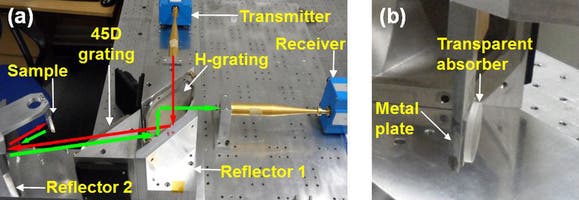Ultra strong, a fantastic electrical conductor, and even suitable for better beer storage, graphene is dazzling the w0rld with its potential applications. Now, it seems there’s another use to add for the growing list of applications for the atom thick hexagon carbon structure. Scientists at Queen Mary University of London and the Cambridge Graphene Centre found that simply by layering a sheet of graphene over a surface increases the latter’s radio wave absorption by up to 90%. This means that you could actually coat the surfaces of an enclosure and make it secure against radio communication.

(a) Photograph of the experimental set-up. Red lines refer to the incident wave from the transmitter to the sample; green lines represent the reflected wave from the sample to the receiver. The H-grating transmits vertically polarized waves but reflects horizontally polarized waves. The 45D grating selects the E-field components with 45° rotation. (b) Photograph of the transparent absorber consisting of graphene-quartz samples backed with a metal plate. Photo: Science
According to the paper published in the journal Science, stacked graphene layers increased the absorption of millimeter waves over a wide bandwidth (125 — 165 GHz, which could be extended down to microwave frequencies) without blocking visibility, since the monolayer graphene is ~98% transparent. With this in mind, one can think of coating the windows of a building with a graphene solution and block radio waves. Businesses or institutions looking to improve their wireless network security would definitely be interested in this.









